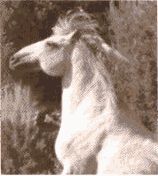|
| ABOUT THE HERD |
Bands of Color
The herd runs from 110 to 120 head. Bays, blacks and sorrels are dominant. Mixtures of grays, pintos, roans, buckskins, browns and palominos can also be seen.
Size
The horses are typically 13 to 15 hands high; weight 800 to 900 pounds
Habitat
This wild horse area encompasses 30,261 acres of rugged canyons and plateaus. Elevations vary from 5,000 to 7,421 feet. Climate is semiarid; droughts are common.
Wildlife
Wintering mule deer, elk, mountain lions, bobcats, coyotes, bald eagles,
hawks, owls, peregrine falcons and golden eagles can be found in the Little
Bookcliffs.
| OBSERVATION TIPS |
Spring and Summer
Beware of frequent summer thunderstorms that can result in flash flood conditions. Roads become slick from rain storms and impassable, even with chains.
Winter Places
Coal Canyon and Main Canyon are excellent viewing areas. Gates into Coal Canyon are closed to vehicles from December 1 through May 31 during the foaling season and for wildlife protection.
Best Chance for Viewing
Park your vehicles and horse trailers at the Coal Canyon Trailhead entrance. You will probably see wild horses around that vicinity, in the North Soda area and around Indian Park. Please keep a respectful distance from the horses so as not to disturb them.
Best Travel
There are many hiking, horseback and four-wheel drive trails in this area. You must stay on designated roads and trails to protect fragile vegetation and soils, especially in the Wilderness Study Area.
| OTHER BOOKCLIFFS LINKS |
-
Wild Horses, Monitoring a Western Legacy
- USGS' presentation on the wild horses.
-
Wild Horse Resources
- Information resources for several herds
-
Little Bookcliffs
- Cowilderness Network's presentation on the HMA.
Continue On
This is not a BLM operated or BLM sponsored site. It is run by private wild horse and burro enthusiasts. We are thankful to the BLM for providing the information which is presented here.


 There is a monument to Velma B. "Wild Horse Annie" Johnston at Indian Park.
With the passage of the 1959 "Wild Horse Annie Act", thousands of Americans
became aware of the plight of the west's wild horses and burros. In 1971,
Congress passed the "Wild, Free-Roaming Horse and Burro Act" because of
Velma's continued efforts and school age children writing to their
congressmen. Little Bookcliffs is one of three herd management areas
dedicated to the memory of "Wild Horse Annie".
There is a monument to Velma B. "Wild Horse Annie" Johnston at Indian Park.
With the passage of the 1959 "Wild Horse Annie Act", thousands of Americans
became aware of the plight of the west's wild horses and burros. In 1971,
Congress passed the "Wild, Free-Roaming Horse and Burro Act" because of
Velma's continued efforts and school age children writing to their
congressmen. Little Bookcliffs is one of three herd management areas
dedicated to the memory of "Wild Horse Annie".